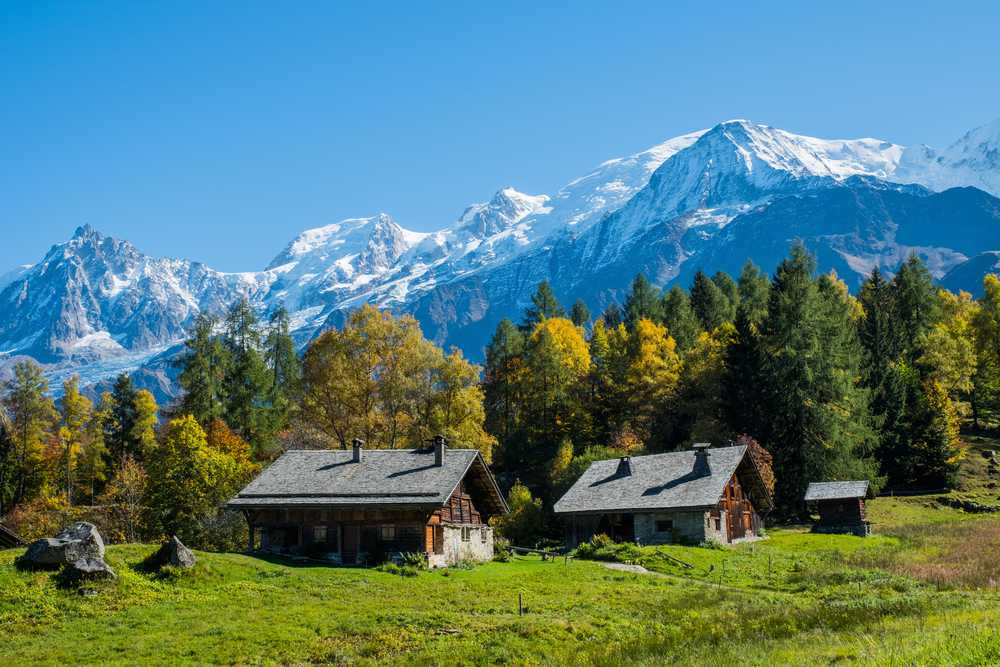Architecture in the French Alps – Part 1: The Alpine Chalet

We work with many of our clients on the design or renovation of their mountain chalet homes, to which we like to bring a modern twist in both the internal layout and the external form. Where did this building typology arise from? Here is a little history & appreciation of the Mountain Chalet and how it has been transformed for 21st century living.
The picturesque landscapes of the French Alps have long captivated travelers with their majestic peaks, serene valleys, and enchanting charm. Amidst this natural beauty, one architectural style stands out—the iconic chalet. Evoking a sense of warmth, coziness, and timeless elegance, chalet architecture in the French Alps seamlessly blends tradition with the breathtaking alpine environment in both summer & winter alike.

Origins and Influences: Chalet architecture traces its origins back to the rural mountain regions of the French & Swiss Alps. Originally serving as simple farmhouses and shelters for herdsmen, chalets have evolved into sought-after retreats and holiday homes. The design of these structures was influenced by the practical needs of the inhabitants, the availability of local materials, and the harsh alpine climate.
Materials and Construction: One of the defining features of chalet architecture is the use of natural materials that harmonize with the surrounding landscape. Timber, stone, and slate are prominently featured, showcasing the region’s rich resources. The upper living areas of the building were traditionally constructed in timber, with thick, interlocking, wooden beams, known as ‘madriers’. Traditional construction techniques, such as mortise and tenon joints, emphasize the craftsmanship and durability of the chalets. This structure was supported on a vaulted stone base, known as a ‘cave’, which would be constructed from locally sourced stone, and using a lime or ‘chaux’ mortar. Small scale quarries can often be found in the vicinity of the mountain villages, with the timber for the beams & planks sourced from the surrounding forest area. The entire structure lives and ‘breathes’ in harmony with the landscape and the passage of the seasons.


Aesthetic Features: Chalet architecture exudes a rustic charm through its distinctive aesthetic features. Steeply pitched roofs with wide overhangs not only shed snow effectively but also create a striking silhouette against the alpine backdrop. Large balconies and terraces provide opportunities for outdoor enjoyment while offering panoramic views. Elaborate woodcarvings and decorative elements, like fretwork and balustrades, add intricate detailing and visual appeal.
Functional Layout: The original mountain chalet would often have encompassed a single living area with small bedroom spaces often interlinked and with minimal or non-existent plumbing. The stone cave would have been used for keeping animals throughout the long winter months. A hayloft is located up under the roof, at the top of the building.

Modern Interpretation: While traditional chalet architecture remains cherished, a more modern interpretation obviously needs to meet the to evolving needs and design sensibilities of the habitants. A contemporary chalet should incorporate elements of sustainable design, such as wood fibre insulation, passive heating and cooling systems, and energy-efficient technologies. In terms of design, it’s important to blend traditional aesthetics with sleek lines and modern materials, creating a fusion of old and new.
In the same way, the interior layout of chalets needs to be designed to maximize comfort and practicality. Open floor plans create space for social interaction after a long day on the ski slopes. Common features include spacious living areas with fireplaces, cozy bedrooms, and well-equipped kitchens. Large windows allow abundant natural light to flood the rooms, framing breathtaking vistas and connecting inhabitants with nature.


Chalet architecture in the French Alps embodies the spirit of the mountains and exemplifies the harmonious coexistence between humans and nature. From humble origins as agricultural shelters, chalets have become iconic symbols of alpine living. The enduring appeal of chalet architecture lies in its ability to create a sense of warmth, tranquility, and connection to the surrounding environment. Whether embracing tradition or embracing contemporary innovations, chalets in the French Alps continue to inspire architects, inhabitants, and visitors alike with their timeless charm.

